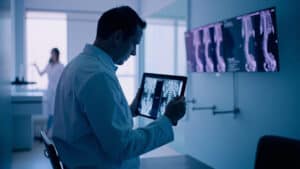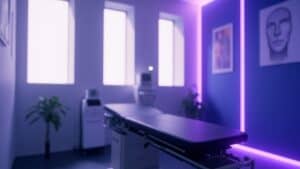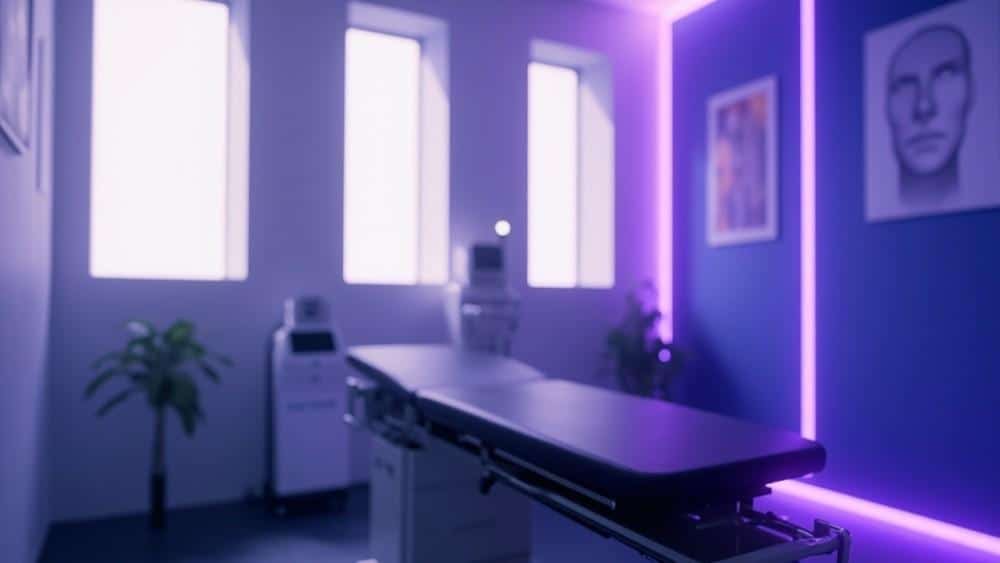Annular Tear in Neck: How Cervical Discs Get Damaged
Written by Dr. Matthias Wiederholz, MD – Quadruple Board Certified, Founder, Performance Pain & Sports Medicine
Quick Insights
An annular tear in neck is a small rip in the tough, outer layer of a cervical disc, often caused by wear-and-tear or sudden injury. This disrupts disc function and can leak inflammatory material, triggering pain and requiring expert evaluation to avoid lasting nerve or mobility problems.1[1]
Key Takeaways
- Annular tears in the neck commonly result in pain, stiffness, and can lead to radiating symptoms down the arm.
- Many patients experience these tears after repetitive motion or accidents, though degeneration is a key risk factor for athletes and active adults.
- Conventional treatments like rest, physical therapy, or basic injections may not address the underlying disc injury effectively.
- Advanced procedures, such as Discseel®, offer non-surgical options proven to restore function and avoid spinal fusion when other therapies fail.
Why It Matters
Understanding annular tear in neck helps you reclaim your active lifestyle before chronic pain sidelines your favorite activities. Quick expert care prevents nerve injury, reduces risk of disability, and supports confident, pain-free movement—empowering you to get back to what you love most. If you want to know more about my expertise, see my full bio here.
As a quadruple board-certified interventional pain and regenerative medicine specialist, I know how a tiny annular tear in the neck can derail both your mobility and your confidence.
An annular tear in the neck is a small rip in the annulus fibrosis—the tough, outer wall of a cervical disc. When this outer ring is compromised, its natural seal fails and the soft disc center, or nucleus pulposus, can leak irritating chemicals that inflame nearby nerves. That’s why what seems like a minor structural injury so frequently leads to throbbing neck pain, stiffness, or even symptoms radiating into your arm. If you’re experiencing upper spine discomfort, learn more about neck pain.
I’ve seen countless patients in Houston sidelined by persistent neck pain, often after sports injuries or just years of active living. Extensive research confirms that annular tears can produce significant, chronic symptoms1[1]—and are often misunderstood or missed during routine care.
Your frustration is real, but precise diagnosis and locally available solutions mean you don’t need to accept a life limited by neck pain.
Discover symptoms of bulging disc in neck C5-C6
What Is an Annular Tear in the Neck?
An annular tear in the neck is a small rip in the tough, outer ring (annulus fibrosis) of a cervical spinal disc. This type of injury occurs when the annular fibers lose their integrity, making way for the disc’s soft inner core (nucleus pulposus) to leak out and trigger inflammation in nearby nerves and tissues.
Key points:
- The annulus fibrosis (outer disc wall) protects the more vulnerable inner core.
- When torn, its seal is compromised—allowing chemical irritants to escape and provoke pain and stiffness.
- A herniated disc is different; there, the inner core fully pushes out through the annulus, possibly compressing nerves.
*In my own clinical experience in Houston and Lawrenceville, I routinely see active patients sidelined by seemingly “mild” MRI findings—only to discover that a small annular tear is the true pain generator. These injuries are subtle, but their impact on daily life can be profound.*
For a more in-depth clinical explanation of annular tears, see this detailed entry on the NCBI Bookshelf—which includes related anatomy and up-to-date concepts.
Learn more about the guide to spinal disc tears—causes, symptoms, and treatments
How Annular Tears Develop
Annular tears often arise across a spectrum of causes: repetitive microtrauma (from sports or physical jobs), sudden impacts (falls, car accidents), or gradual disc degeneration with age. *As a quadruple board-certified interventional spine expert, I see that even high-level athletes, who often engage in repetitive spinal movements, may be at increased risk for annular tears, which can potentially lead to chronic neck pain if undiagnosed. Genetics and overall disc health also play a role.*
Fast Fact:
Recent orthopedic outcomes research confirms that even small tears in the cervical disc’s annulus can lead to nerve irritation, persistent pain, and measurable drops in daily function, especially for active or working adults (see orthopedic studies).
Explore effective treatment options for L5-S1 disc herniation pain
Annular Tears vs. Herniated Discs
While both injuries involve disc structure damage, the key distinction is:
- Annular tear: Only the tough outer ring is split, typically allowing only chemical irritants to leak out.
- Herniated disc: The gelatinous core pushes all the way through, sometimes compressing nerves outright.
*In my practice, I’ve seen annular tears misdiagnosed as simple muscle strain, despite causing sharp, radiating pain down the arm. That’s why precise diagnosis—not just “rest and ice”—is vital.*
Comprehensive guide to L5-S1 bulging disc

Symptoms and Causes of Cervical Annular Tears
Annular tears in the neck can have effects that range from intermittent stiffness to disabling nerve pain. *It’s not uncommon for patients to tell me they initially dismissed their symptoms as regular tension—until weakness, numbness, or persistent pain interrupted their daily lives or sports activities.*
Common Symptoms
- Constant or intermittent neck pain, worse with movement
- Sharp, burning, or throbbing discomfort—sometimes radiating to the shoulder or arm
- Tingling or “pins and needles” in the hands or fingers
- Loss of grip strength or dexterity
- Increased pain after prolonged sitting, computer work, or overhead movement
Clinical Observation:
*“In my practice, I frequently meet patients who’ve cycled through therapy, medications, or even surgery for ‘neck pain,’ yet continue to struggle. Too often, the underlying torn disc in neck goes undetected until advanced imaging and thorough examination pinpoints the real cause.”*
Read about emergency symptoms of a herniated disc
Risk Factors and Triggers
Key risk factors for a cervical annular tear include:
- High-impact or repetitive neck motions (sports, weightlifting, manual labor)
- Aging (natural disc degeneration)
- Sudden trauma (car accidents, sports collisions, falls)
- Genetic predisposition or previous neck injuries
According to ongoing clinical research from the AO Foundation, changes in spinal disc structure—even small, seemingly minor tears—can disrupt nerve communication and seriously impact neck biomechanics (see AO Foundation report).
Orthopedic studies further show that active individuals—especially those in professions requiring frequent neck movement—are at notable risk for annular tears with life-altering symptoms (see orthopedic outcome research).
Experience-Based Insight:
*“Having performed thousands of regenerative procedures for neck and spine problems, I’ve seen that missed or underestimated annular tears are a leading reason why patients struggle to return to full activity—even after other treatments have failed.”*
Understand the causes, symptoms, and treatment of disc desiccation
When to Seek Medical Attention
Seek expert help immediately if you experience:
- Sudden, severe neck pain after injury
- Loss of arm strength, coordination, or numbness lasting more than a few days
- Persistent pain that interferes with daily tasks, sleep, or work
Rapid diagnosis can prevent long-term nerve problems or more severe complications.

Diagnosis and Common Misdiagnoses
Cervical annular tears are notorious for being overlooked—largely because the symptoms mimic those of muscle strain or arthritis, and because standard imaging may miss small tears.
Diagnostic Tests Used
I rely on a multi-step process for accurate diagnosis:
- Comprehensive patient history and targeted neurological exam
- High-resolution MRI (often with contrast—especially for subtle tears)
- Provocative discography (injecting dye and saline into the disc under guidance, reserved for select, complex cases)
- Advanced blood tests to check inflammatory markers (when indicated)
Recent surgical abstracts highlight the importance of confirming inflammation and nerve irritation alongside imaging for a confident diagnosis. These approaches may reveal why many conventional treatments fail (read more in surgical abstracts).
Professional Assessment Phrase:
*“As a quadruple board-certified regenerative medicine specialist, I’ve observed that matching a patient’s symptoms with modern diagnostics is critical. This lets us target advanced, precise treatments—especially when conventional scans fall short.”*
Why Annular Tears Are Misdiagnosed
- Small tears may be missed on standard MRIs, especially if there’s no major disc bulge.
- Neck pain is often labeled as muscular or “age-related,” leading to ineffective therapy or medications.
- Some general clinics may have limited experience with advanced cervical disc imaging techniques and might not routinely perform discograms, potentially affecting the diagnosis of subtle annular tears.
*Unlike larger clinics, where patients may bounce from provider to provider, I personally oversee every detail—from initial consult to imaging review and treatment plan. This ensures subtle but significant cervical disc tears don’t go unnoticed.*
Annular tear of lumbar disc—understand more
Treatment Options for Annular Tears in the Neck
Treatment for a cervical annular tear must go beyond generic pain management—it should focus on true healing and lasting function preservation. My protocol always starts with the right diagnosis and a patient-centered, stepwise plan.
Conservative Treatments
- Rest and modified movement to reduce acute inflammation
- Physical therapy targeting neck stabilization, posture education, and gentle mobility restoration
- Anti-inflammatory medications as needed
- Basic neck pain injection therapy (such as trigger point or epidural injections), which can offer temporary pain relief
*However, studies confirm that these options rarely heal the actual tear in the annulus for patients with persistent symptoms. Long-term outcomes are mixed, with many patients returning for more injections or considering surgery (see research on treatment outcomes).
Exercises to help herniated disc symptoms

Minimally Invasive Options (Discseel® Procedure)
For select patients—especially those who don’t improve after conservative care—I offer the Discseel® Procedure, a groundbreaking, non-surgical solution. Here’s what sets it apart:
- Biologic repair: A special fibrin sealant (the same protein your body uses to heal wounds) is gently injected to seal the torn annulus and stimulate new tissue growth.
- No hardware, no fusion: Unlike traditional spinal surgery, there are no incisions, metal implants, or risks of fusion-related complications.
- Preserves movement: You keep your normal, natural neck motion.
- Rapid recovery: Most patients return to activities in days—not weeks or months.
*Comparative Expertise:*
*“Unlike larger spine practices where your treatment may change hands multiple times, I personally perform every Discseel® injection from start to finish—drawing on direct training from the procedure’s inventor, Dr. Kevin Pauza, and my experience as a master instructor. This means safer, more predictable results, and the compassionate care my patients deserve.”*
Clinical data shows Discseel® achieves an 82% success rate—dramatically higher than the 31% reported for spinal fusion, and with far fewer long-term complications (see success rate comparisons).
Fast Fact:
Discseel® directly repairs the “leaky cervical disc”—offering true healing while avoiding unnecessary surgery, long hospital stays, or disruptive recoveries.
Discseel® reviews: achieving lasting back pain relief
Why Surgery Isn’t Always the Answer
Spinal fusion or disc replacement may be offered as a last resort, but these surgeries:
- Carry significant risks (infection, adjacent segment breakdown, loss of neck flexibility)
- May require lengthy hospitalizations and rehabilitation
- Alter your natural spine mechanics
*My approach, consistent with leading spine specialists nationwide, prioritizes regenerative, minimally invasive techniques that heal the source—not just mask the symptoms. We’ve found that most patients do best with procedures that preserve their own anatomy, whenever possible (see functional outcome studies).
If you’re struggling with a cervical disc tear in Houston (or at our Lawrenceville clinic), know that you do not have to “settle” for major surgery as your first or only choice.
Learn more about degenerative disc disease treatment options

Why Choose Discseel® and Dr. Matthias Wiederholz in Houston?
Your choice of provider influences whether you simply manage symptoms or achieve true recovery and lasting function.
Dr. Wiederholz’s Credentials & Experience
Dr. Matthias Wiederholz, MD, is one of just three global master instructors for Discseel®, personally trained by the procedure’s inventor and with over 10,000 advanced regenerative treatments performed. My four board certifications reflect a commitment to clinical excellence, functional restoration, and staying at the forefront of non-surgical spine care for patients in Houston, Lawrenceville, and beyond.
- Nationally recognized authority in regenerative spinal medicine
- Only certified master instructor offering cervical Discseel® in Houston and New Jersey
- Direct, compassionate care from your initial consult through every follow-up
- Treatments based on leading-edge research and real patient success
Our Concierge-Style Approach
At Performance Pain & Sports Medicine, you won’t be rushed or lost in a large hospital system. *I provide personalized, boutique-level service—thorough evaluation, clear explanations, and a tailored plan built around your goals and lifestyle.* All advanced regenerative procedures are performed in-office, under local anesthesia.
Our care model aligns with the philosophy of other top spine specialists, such as Dr. Alexander Satin at Texas Back Institute, who also prioritizes individualized care and minimally invasive treatments to preserve spine function (learn more about function-preserving approaches).
Read about cervical herniated disc symptoms and treatment

What Our Patients Say on Google : Patient Success Stories
Patient experiences are at the heart of my approach to treating complex spine conditions. Hearing directly from those who have faced years of pain and uncertainty reminds me why advanced, minimally invasive solutions matter.
I recently received feedback that captures what we aim to provide for every patient seeking relief from disc injuries:
Testimonial ★★★★★
“Dr. Wiederholz was extremely patient and explained numerous options available to help manage my pain… He is the greatest and literally gave me my life back! I highly recommend him to anyone dealing with pain.”
— Linda, Google Review Read Linda’s full Google review here
You can read more Google reviews here to see how our approach has changed lives.
Stories like this reinforce my commitment to providing advanced, non-surgical options for patients with annular tears in the neck and spine.
Read more: L5-S1 herniated disc surgery overview
Annular Tear in Neck Care in Houston, TX
Living in Houston, TX means access to some of the most advanced spine care options in the country. Our city’s active lifestyle and diverse population often lead to unique challenges when it comes to neck and spine health.
Many Houstonians work in physically demanding industries or enjoy recreational sports, both of which can increase the risk of developing a torn disc in the neck. Factors such as prolonged commutes and environmental conditions may contribute to neck discomfort, though individual experiences can vary.
At Performance Pain & Sports Medicine, I am proud to offer the Discseel® Procedure and other regenerative solutions right here in Houston. As the first physician in the area to provide this innovative treatment, I ensure that every patient receives a thorough diagnosis and a personalized plan designed for lasting relief.
If you’re in Houston and struggling with persistent neck pain or a leaky cervical disc, don’t wait for symptoms to worsen. Schedule a consultation to discover if you’re a candidate for advanced, non-surgical healing and get back to the activities you love.
Managing L4-L5 pain and symptoms
Conclusion
An annular tear in neck can disrupt your life, but you don’t have to accept chronic pain or limited mobility. My advanced regenerative approach—including the Discseel® Procedure—directly targets the source of your symptoms, helping you return to the activities you love without invasive surgery. Patients in Houston benefit from my boutique, patient-centered care model, where every treatment is tailored to your unique needs and goals.
As a quadruple board-certified regenerative spine specialist and master Discseel® instructor, I am dedicated to restoring both your function and your confidence. Research shows that patients experience better long-term outcomes and satisfaction with non-surgical disc solutions. If you’re ready to stop missing out on life due to neck pain, I invite you to take the next step. See if you are a candidate for the Discseel® Procedure—schedule your consult today at (346) 217-1111 (Houston) or (609) 588-8600 (Lawrenceville), or use my secure online form. Early intervention leads to better results. Let’s help you reclaim your life.
*This article is for educational purposes only and should not be used as a substitute for professional medical advice, diagnosis, or treatment. Always seek the advice of your physician or other qualified healthcare provider with any questions you may have regarding a medical condition or treatment options. Never disregard professional medical advice or delay in seeking it because of something you have read in this article.*
Frequently Asked Questions
What is an annular tear in the neck?
An annular tear in the neck is a small rip in the tough outer layer of a cervical disc. This injury can let irritating material leak out, causing pain, stiffness, or even nerve symptoms. Many patients notice pain that worsens with movement or radiates into the arm.
Where can I find advanced treatment for a torn disc in the neck in Houston?
You can find advanced, non-surgical care for a torn disc in the neck at my Houston practice, Performance Pain & Sports Medicine. I offer the Discseel® Procedure and other regenerative options, providing personalized treatment plans and prompt appointments for patients throughout Houston and the surrounding area.
How do you help patients who have tried physical therapy or injections without relief?
If you’ve tried physical therapy or neck pain injection therapy without lasting results, I focus on identifying the true source of your pain. My approach uses advanced diagnostics and minimally invasive regenerative treatments, like Discseel®, to directly repair the damaged disc and restore your function—even when other therapies have failed.
—
References:
Looking to discuss options for your cervical disc tear in Houston or Lawrenceville? Contact us here.















